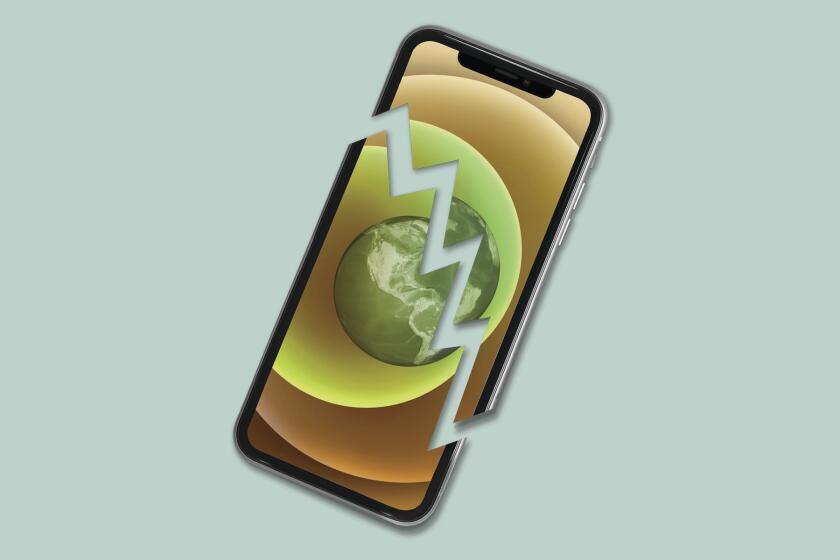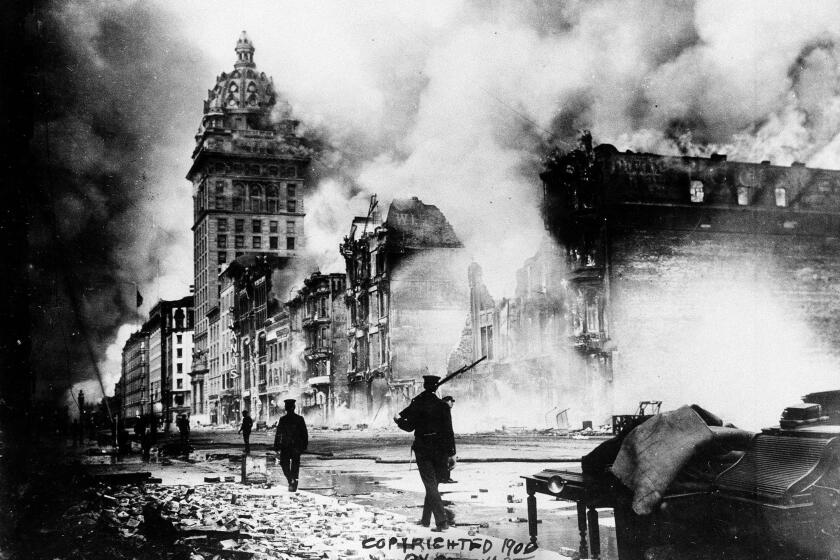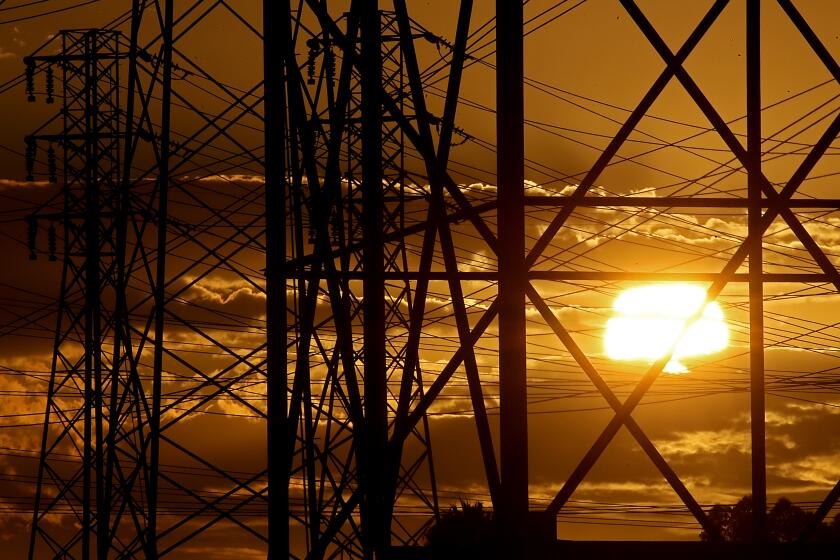At least 2 dead, 11 injured after 6.4 earthquake in Northern California
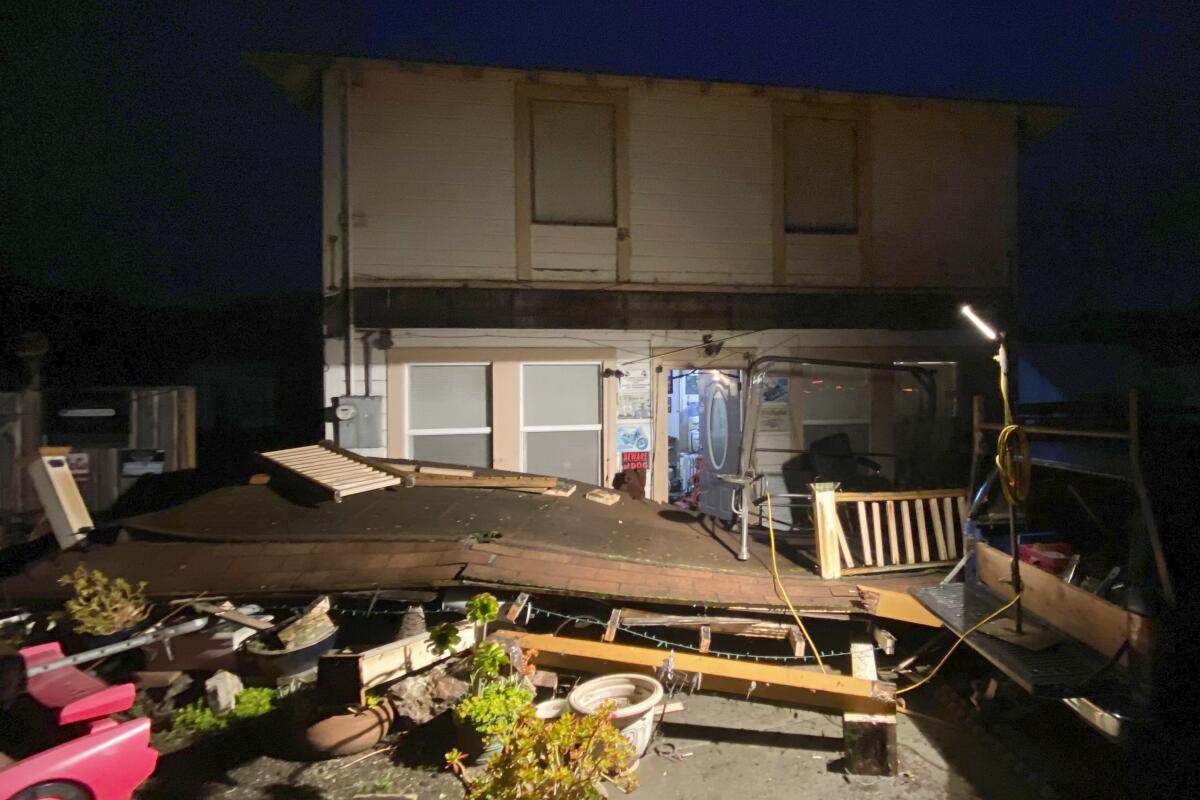
- Share via
FORTUNA, Calif. — A powerful earthquake jolted Humboldt County early Tuesday, leaving at least two people dead, tens of thousands without power and widespread damage in its aftermath.
Even in this seismically active region of Northern California known for large temblors, the 6.4 magnitude quake felt particularly violent to many longtime residents. Officials were still trying to tally the destruction hours later.
The force of the shaking shattered windows, sent objects flying and damaged at least one historic bridge in the small communities south of Eureka. At least 11 people were injured.
“It was the most intense earthquake that I’ve felt,” said Rio Dell Mayor Debra Garnes, whose hamlet was hard hit. “It was a long-duration earthquake, so it was not only significant in size at 6.4, it was also long.”
More than 3 million people were notified by phone early Tuesday of a 6.4 magnitude earthquake that shook Northern California.
According to the Humboldt County Sheriff’s Office, two people died as a result of medical emergencies during or just after the earthquake.
There was one fatality in Rio Dell during the earthquake, Garnes said, but it is unclear whether it was among the two deaths reported by the Sheriff’s Office.
A call came in during the earthquake about someone having difficulty breathing. The person went into cardiac arrest, and medics performed CPR, Garnes said. The person was taken to a hospital but did not survive.
The quake was reported at 2:34 a.m. just offshore about 7½ miles southwest of Ferndale, according to the U.S. Geological Survey. No tsunami was expected, the Humboldt County Sheriff’s Office said on Twitter, but the agency advised residents to prepare for aftershocks.
Ferndale, Fortuna and Rio Dell were among the hardest hit areas, Mark Ghilarducci, the director of the California Governor’s Office of Emergency Services, said at a news conference Tuesday.
Residents shared photos across social media of destroyed homes, with appliances and furniture toppled over, and tales of violently strong shakes, the strongest they’ve experienced in decades. Ghilarducci said the quake could be felt as far east as Redding and as far south as in the Bay Area.
“It wasn’t as large as it could have been, but still we have seen this one resulting in damage, both structural and nonstructural damage,” he said.
The earthquake battered homes, knocked some off their foundations, caused at least one structure fire, and damaged critical infrastructure such as water, power and gas lines. At one point Tuesday, about 71,000 people were without power, Ghilarducci said.
Pacific Gas & Electric tweeted Tuesday morning that it had “initiated its emergency response plan, and crews are responding to gas and electric hazards.”
Crews had restored power to about 40,000 customers, “more than half of those who experienced outages,” by Tuesday night, said Megan McFarland, a PG&E spokesperson.
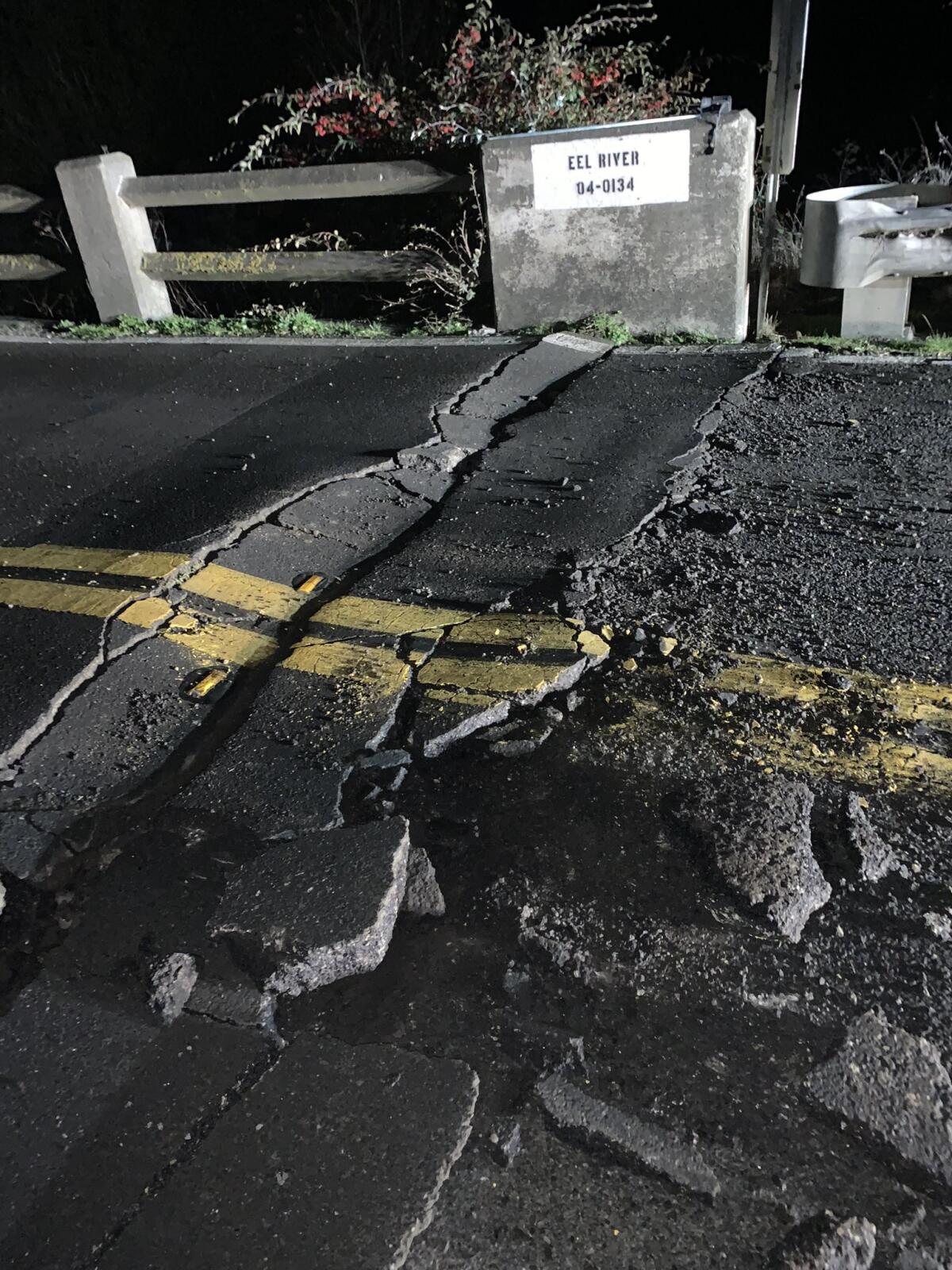
Ghilarducci said the state sent out an early warning, a new system that pushed out an alert 10 seconds in advance of the earthquake’s shaking to some 3 million people in Northern California, giving residents the opportunity to drop, cover and hold or get to a place of safety.
“The system did operate as we had hoped, and that we’ve been working to design,” he said.
Gov. Gavin Newsom declared a state of emergency for Humboldt County, granting it state disaster resources, requesting federal assistance and easing access to unemployment benefits.
The State Operations Center was activated to coordinate the emergency response with local and tribal governments, and provide any resources needed.
“Jennifer and I send our heartfelt condolences to the families grieving the loss of loved ones and offer our best wishes for the recovery of those who were injured in this earthquake,” Newsom said in a statement. “California stands with the people of Humboldt County and the state has moved quickly to support the emergency response underway with local and tribal partners.”
The governor has directed state agencies and departments to take “appropriate action as necessary” in order to support local communities, according to the statement.
Humboldt County Sheriff William Honsal declared a local emergency, a move that allows the county to seek state and federal reimbursement for damage repairs and other costs, officials said.
Disruptions from a major quake would be serious and long-lasting. Here’s what could happen in Southern California if a large earthquake struck on the San Andreas fault.
Damage assessments throughout the county were ongoing Tuesday, including by teams inspecting local infrastructure. The Fernbridge, a historic bridge connecting the community of Ferndale with U.S. 101, suffered some damage and was closed, officials said.
Agencies are also determining impacts to water delivery systems and transmission lines, and how many people may be displaced because of the quake. Rio Dell Fire Chief Shane Wilson told local news outlet Redheaded Blackbelt that 50 to 100 families were uprooted.
The Humboldt County Office of Emergency Services issued boil-water advisories for Rio Dell and the following areas of Fortuna: Forest Hills Drive, Newell Drive, Valley View Drive, Boyden Lane, Scenic Drive, and Cypress Loop Road.
“DO NOT DRINK THE WATER WITHOUT BOILING IT FIRST,” county officials wrote in a Facebook post. “Bring all water to a boil, let it boil for one (1) minute, and let it cool before using, or use bottled water. Boiled or bottled water should be used for drinking and food preparation until further notice. Boiling kills bacteria and other organisms in the water.”
Potable water is available at Rio Dell Fire Hall, 50 West Center St.; and Rohner Park Pavillion, 9 Park St. in Fortuna, the officials said.

The earthquake was two miles offshore, said Cindy Pridmore, a geologist with the California Geological Survey, and was on the Gorda plate, a complex area where several plates, including the Pacific Plate, the North America plate and small pieces of other plates intersect. The area has registered over 40 earthquakes in the last 100 years that were magnitudes 6 to 7.
There have been an estimated 80 aftershocks, including a 4.6 quake near Rio Dell, where much of the damage is concentrated. There was no tsunami risk because the plates were moving side by side, Pridmore said.
The U.S. Geological Survey’s earthquake forecast shows a 13% chance of a magnitude 5 or larger earthquake in the next week, Pridmore said, but that could change. “People do need to be prepared, especially if they’re in weakened structures, to be mindful of where they’re staying,” Pridmore said.
Officials stressed the importance of having a plan and advised residents to download the ShakeAlert early warning system app on their smartphones, which they described as a critical tool for residents.
“We live in earthquake country,” Ghilarducci said. “This is another example of the fact that earthquakes can occur at any time.”
‘It was the most intense earthquake that I’ve felt,’ said the mayor of Rio Dell, Calif., which along with Ferndale took the brunt of the quake.
In Rio Dell, Mayor Garnes said the “biggest issues are no electricity and no water.”
“Structural damage is the next thing on the list,” she said. “Our water system got really wrecked. So many leaks.”
Nearby Eureka looked like a ghost town. Strip malls along the 101 Freeway were dark, and the parking lots in front of Old Navy, Chipotle and Bed, Bath and Beyond were empty.
The city’s Costco, however, was buzzing with a steady stream of shoppers flowing into the store, which was powered by a generator.
Nino and Jessica Lopresti heard Costco was open via the “ice cream truck express” — a local description of the slow, steady, informal mode of information sharing that occurs in Humboldt County.
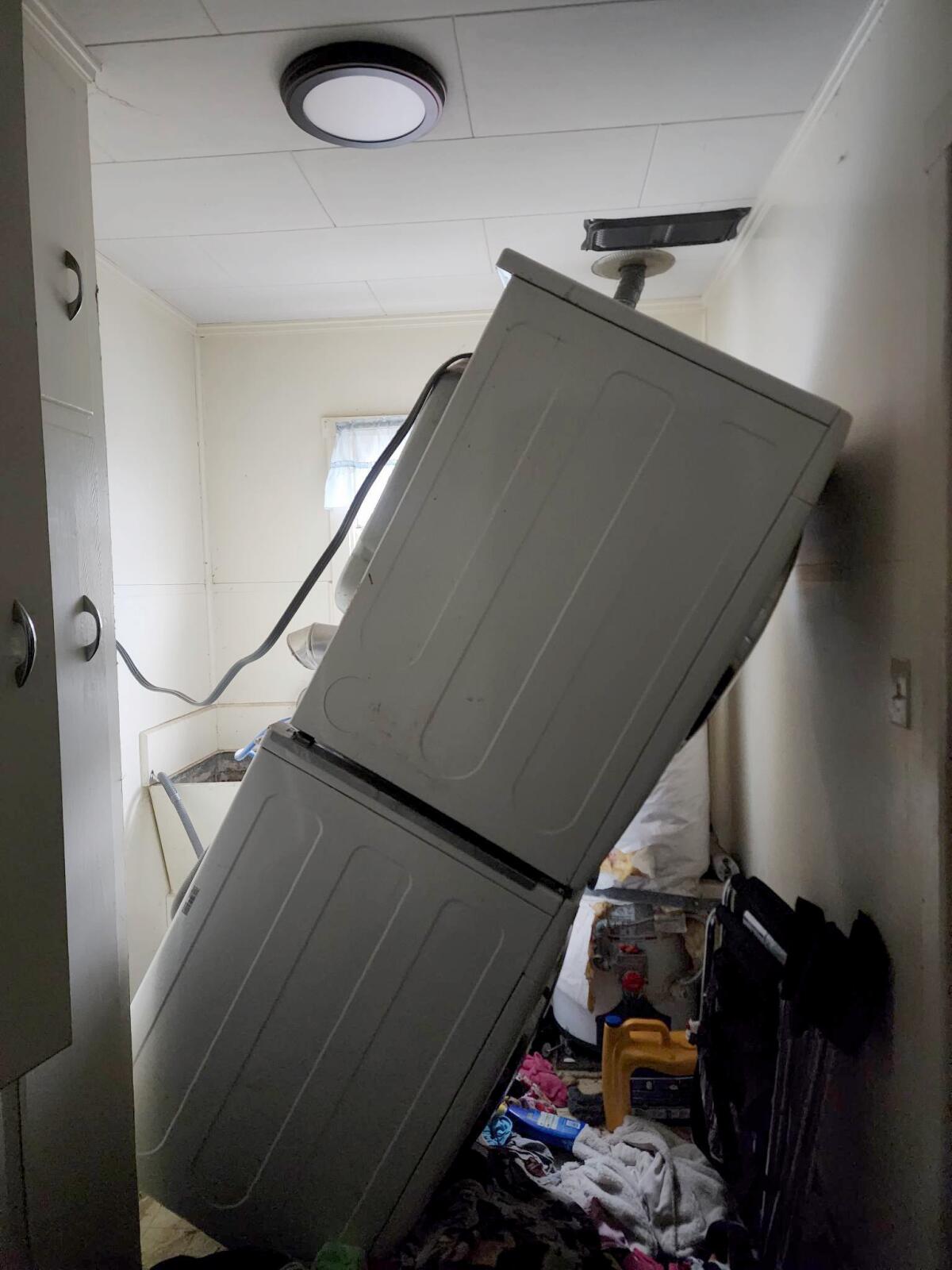
Lifelong Humboldt County resident Andrea Wrisley, 34, woke up Tuesday morning and immediately recognized an earthquake. Wrisley went to check on her two daughters and saw that everything in the kitchen, including all of her glassware and the contents of the fridge, had been emptied onto the floor. The power and water were also both out.
Rio Dell evacuated Wrisley’s entire neighborhood because it is near an elementary school that had a gas leak. She and her family went to her in-laws’ house for about five hours before they were allowed to return to their residence.
“This definitely has been the most serious one we’ve had in quite some time,” she said. “Most of the time, we have tiny shakers and we’ll maybe lose a plate or a cup or something. This is definitely going to be intimidating to those who are less familiar with earthquakes.”
Arcata residents Amy Uyeki and Rees Hughes were asleep when they felt the earthquake. The power went off immediately.
People are much more important than kits. People will help each other when the power is out or they are thirsty. And people will help a community rebuild and keep Southern California a place we all want to live after a major quake.
“Afterwards, you feel sort of dizzy,” Uyeki, 67, said. “When it was happening, I thought it was the big one, because we haven’t felt anything this strong.”
The couple dropped to the floor and said the shaking lasted about 15 seconds. “This was very disconcerting, because it happened at nighttime, and you can’t see how much has gone down until you go around with your flashlight,” Hughes, 69, said.
The earthquake yanked shelves off the walls and broke some items in the house, but the house’s structure was undamaged. Hughes said the last time he felt an earthquake of this magnitude was in April 1992, when a 7.1 quake rattled Humboldt County.
The Governor’s Office of Emergency Services said on Twitter that it was coordinating with local and tribal governments on damage assessments and support with aid and other resources. The California Department of Forestry and Fire Protection, the California Geological Survey and the California Department of Transportation are among the agencies assisting in response efforts.
New research finds that violent supershear earthquakes are more common than previously believed, particularly along mature strike-slip faults like the San Andreas.
The Red Cross set up an overnight shelter for displaced people at Rohner Park Firemen’s Pavillion, 9 Park St. in Fortuna.
“At this site, community members will be able to access temporary indoor overnight shelter accommodations, meals, water and earthquake information,” officials said. “For shelter-specific questions and information, contact 707-506-5083.”
State Sen. Mike McGuire, a Democrat who represents Humboldt County, said that both state and local emergency systems have so far worked well together in this isolated coastal corner of California. “It’s a remote area,” McGuire said. “All levels of government [are working] together to ensure a rapid response.”
While those closer to the epicenter reported feeling the quake, the shaking was actually weaker than expected at greater distances, said Richard Allen, a seismologist and director of the UC Berkeley Seismological Laboratory.
Few people felt it in the Bay Area, Allen said.
“This is getting up there, but it’s not at the level where events do a lot of damage,” Allen said. “This is reminder of the impact of earthquakes and the impact that it’s going to have on us.”
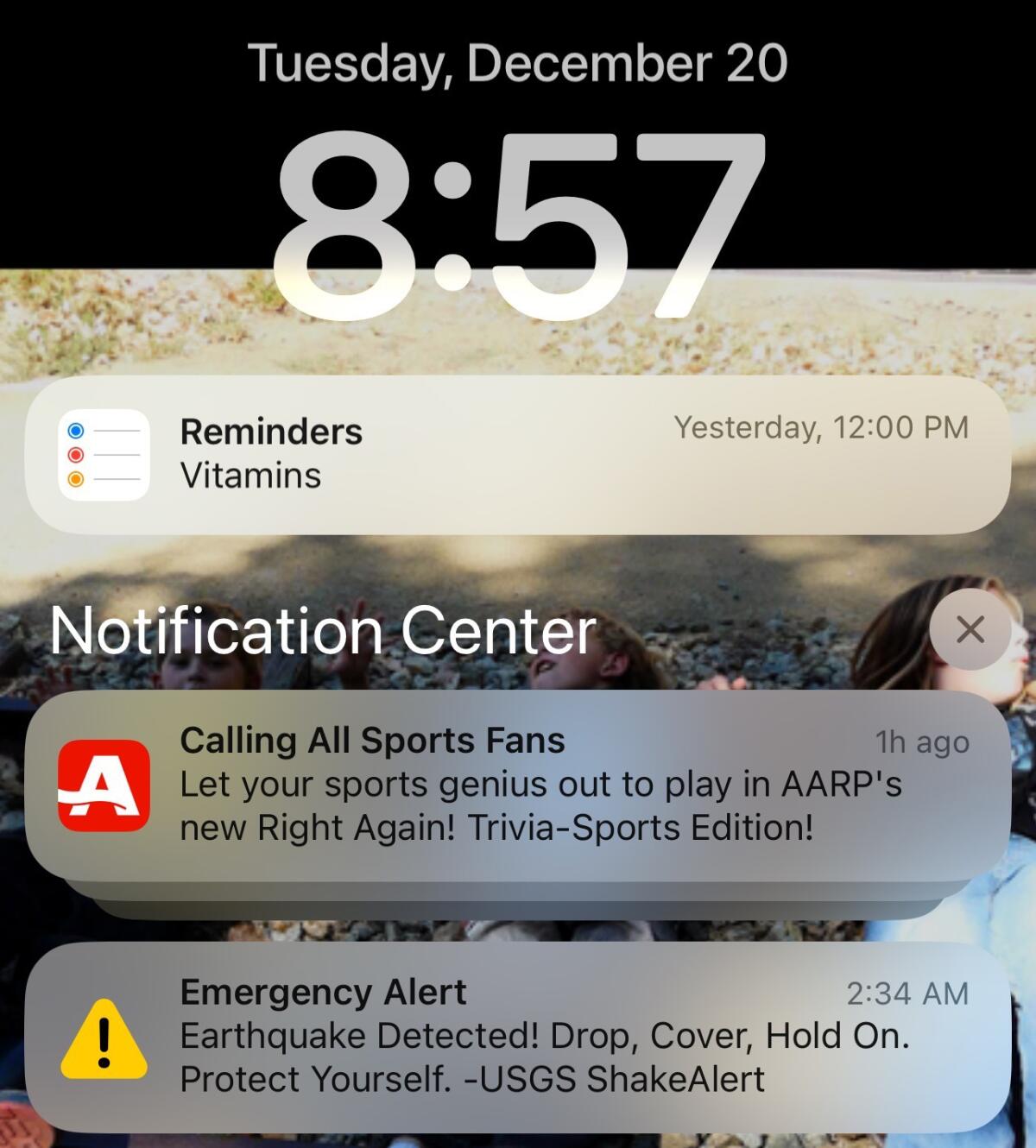
Many residents reported receiving an alert on their phone, including during the event.
Greta Turney, superintendent of the Kneeland Elementary School District, whose sole campus, Kneeland Elementary, was closed Tuesday, said in a text that she received her earthquake alert on her phone as she was “transfixed” by her swaying ceiling fan.
A screenshot of the notification she posted shows it came in at 2:34 a.m. from the U.S. Geological Survey and read “Earthquake Detected! Drop, Cover, Hold On. Protect Yourself. —USGS ShakeAlert.”
Turney, who lives in Kneeland, about 15 miles from Eureka, said in a text that colleagues, friends and family in Eureka and Arcata reported shattered glass from mirrors and broken dishes and cups that fell during the quake. One friend had her kitchen ceiling cave in, Turney said.
Be in the loop when disasters — like extreme heat or a hurricane this week, or earthquakes, tsunamis and wildfires at other times — are headed California’s way.
Jennifer Savage, 53, who lives on the Samoa Peninsula just outside Eureka, said she’s familiar with earthquakes, particularly small rumbles that hardly rouse her from bed.
But “this was scary,” she said, adding that she received an alert, but her phone was on “Do Not Disturb” mode. “It was just really a violent shaking, not one of those rolling ones,” Savage said.
Her home was littered with broken glass, mostly from picture frames and cups falling off the walls and shelves. A glass of water on a bedside table wound up drenching her, she said.
“We were up for a while trying to do the best we could cleaning it up in the dark with a flashlight,” Savage said.
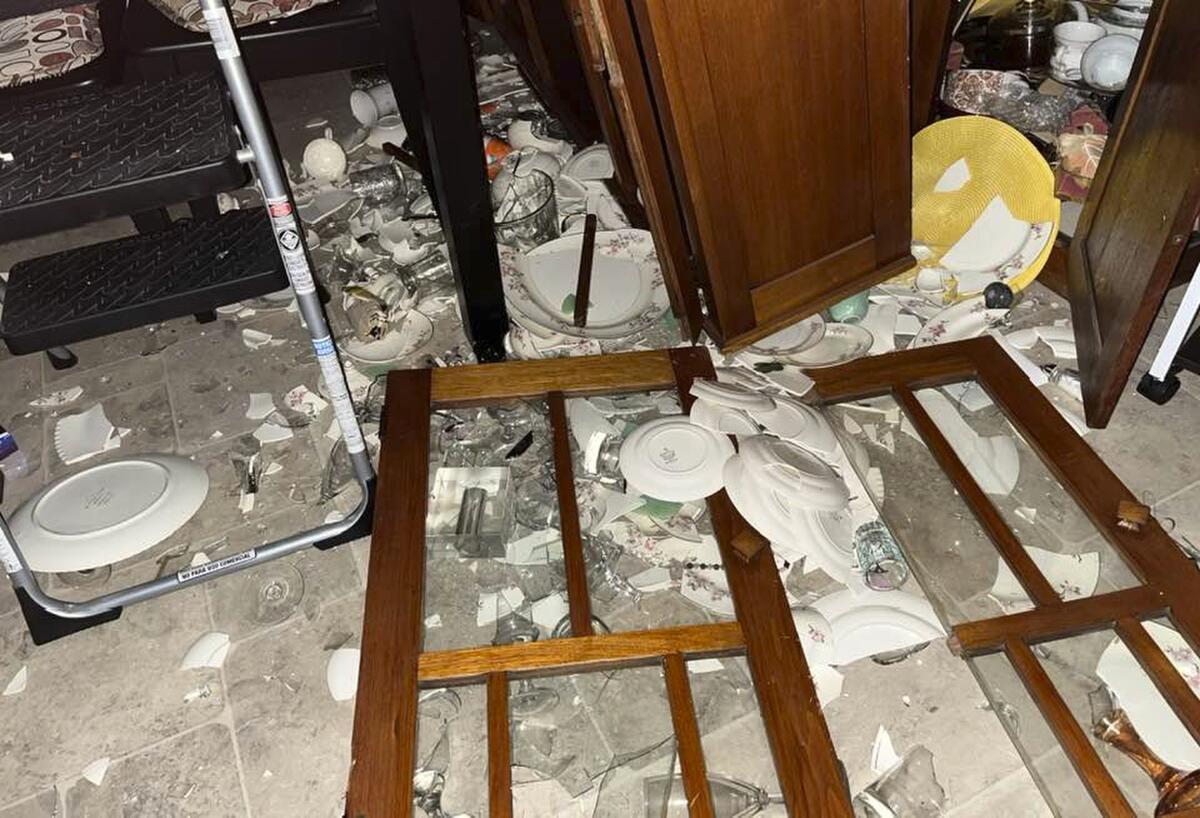
Shannon Eggel, 45, a Ferndale resident, was asleep on a reclining couch Tuesday morning when she was jolted awake.
“The whole house started jerking really hard, almost like when you’re on a sled and it starts skidding,” she said.
Eggel said she, her husband and her oldest son, who lives with them, were uninjured in the earthquake but that the entire house was a “chaotic mess.”
Earthquakes
More resources
— One of the most important things you can do to prepare for an earthquake is talk to your neighbors, writes seismologist Lucy Jones.
— Thinking of buying a premade earthquake kit? We unboxed four of them, from $30 to $300.
— If all you have to eat in your emergency kit are granola bars and canned tuna, here’s how to up your game. Plus here’s some advice from L.A. food people.
— How does California’s earthquake early-warning system work? And what apps should you have on your phone?
Eggel lived through the April 1992 earthquake but said Tuesday’s quake did a lot more damage because its epicenter was much closer to their house. “This one was so aggressive,” she added.
The quake struck along the coast south of Eureka in a seismically active part of California. It was felt across the North Coast region.
Exactly one year ago, the same area was hit by a magnitude 6.2 quake that shattered windows and caused other damage.
The USGS said Tuesday’s quake occurred just offshore, 17 miles from Eureka, 24 miles from Arcata and 30 miles from McKinleyville. It was followed by numerous aftershocks.
In the last 10 days, there have been no earthquakes of magnitude 3.0 or greater centered nearby.
An average of five earthquakes with magnitudes between 6.0 and 7.0 occur each year in California and Nevada, according to a recent three-year data sample.
Times staff writers Hannah Wiley, Laurel Rosenhall, Hailey Branson-Potts and Gregory Yee contributed to this report. Mays and Rust reported from Humboldt County.
More to Read
Sign up for Essential California
The most important California stories and recommendations in your inbox every morning.
You may occasionally receive promotional content from the Los Angeles Times.

